By Chris Grinter, on July 25th, 2011 This Monday I am departing from the usual Arctiinae for something completely different – a microlep! This is a Nepticulidae, Stigmella diffasciae, and it measures in at a whopping 6 mm. I can’t take credit for spreading this moth – all of the nepticulids I have photographed are from the California Academy of Sciences and spread by Dave Wagner while he was here for a postdoctorate position.
The caterpillars mine the upper-side of the leaves of Ceanothus and are known only from the foothills of the Sierra Nevada in California. If you’re so inclined the revision of the North American species of the genus is freely available here (.PDF).
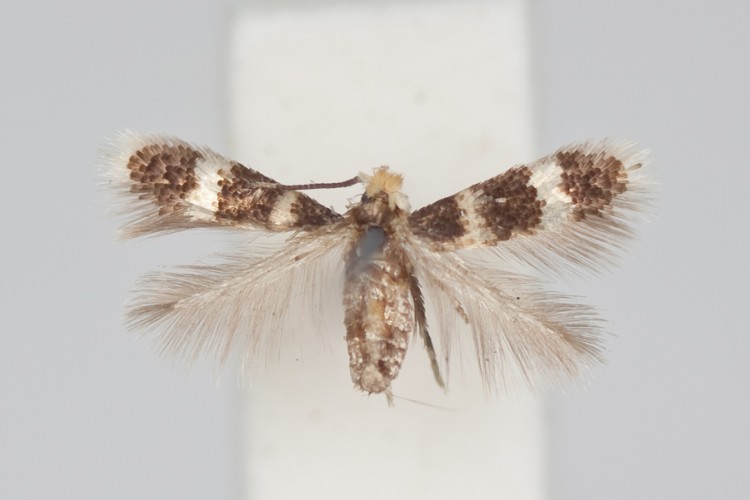 Stigmella diffasciae (Nepticulidae)
By Chris Grinter, á júlí 22, 2011 Það hefur verið smá stund síðan síðasta GOP áskorun, en this is a softball. Ég vona að þeir voru bara of latur til að finna meira viðeigandi mynd…

By Chris Grinter, þann 19. júlí, 2011 Hvað myndi Jesús gera ef hann hefði frítíma – kannski lækna sjúkdóm, enda stríð, eða fæða sveltandi – en nah, allir sjá þetta koma. Af hverju ekki að sjokkera þá til mergjar – brenna andlit þitt á Walmart kvittun! Að minnsta kosti, that’s what a couple in South Carolina believe to have found, a Walmart receipt with Jesus’s face on it. This isn’t exactly new or exciting, humans have a wonderful ability to recognize a face in just about anything. Jesus and other characters “appear” on random things all the time, and even in 2005 a shrine was built to the Virgin Mary around a water stain in a Chicago underpass.
Pareidolia anyone? Raunverulega, that face looks pretty convincing, I’m not too sure this wasn’t just faked or “enhanced”. The closeups even look like there are fingerprints all over it. Since I don’t have a walmart anywhere near me or a walmart receipt on hand I can’t determine how sensitive the paper is and how easy it would have been to do – but how long do you think before it shows up on ebay? Í öllum tilvikum, it looks much more like James Randi to me than Jesus (at least we actually know what Randi looks like!).
 from CNN
By Chris Grinter, á Júlí 18, 2011 Yfir á Arthropoda, náungi SFS bloggarinn Michael Bok deildi mynd af félaga sínum á sviði, Tengdu græna trjáfroskinn. Fyrsta sem ég hugsaði var um svipaðan trjáfrosk sem reimt tók á móti mér hvert sem ég fór í Santa Rosa þjóðgarðinum, Kosta Ríka. það þarf ekki að taka það fram, Kosta Ríka innrætir skyndilega vana að athuga allt sem þú ert að fara að gera. Þessi tegund er þekkt sem mjólkurfroskurinn (Phrynohyas venulosa) fyrir mikið magn þeirra af mjólkurhvítu eitruðu seyti. Ein af fyrstu sögunum sem Dan Janzen sagði mér á meðan ég var með honum í Santa Rosa var um þessa tegund – og nuddaði augað fyrir slysni eftir að hafa haldið því. Sem betur fer blindu og sviða var aðeins tímabundið.
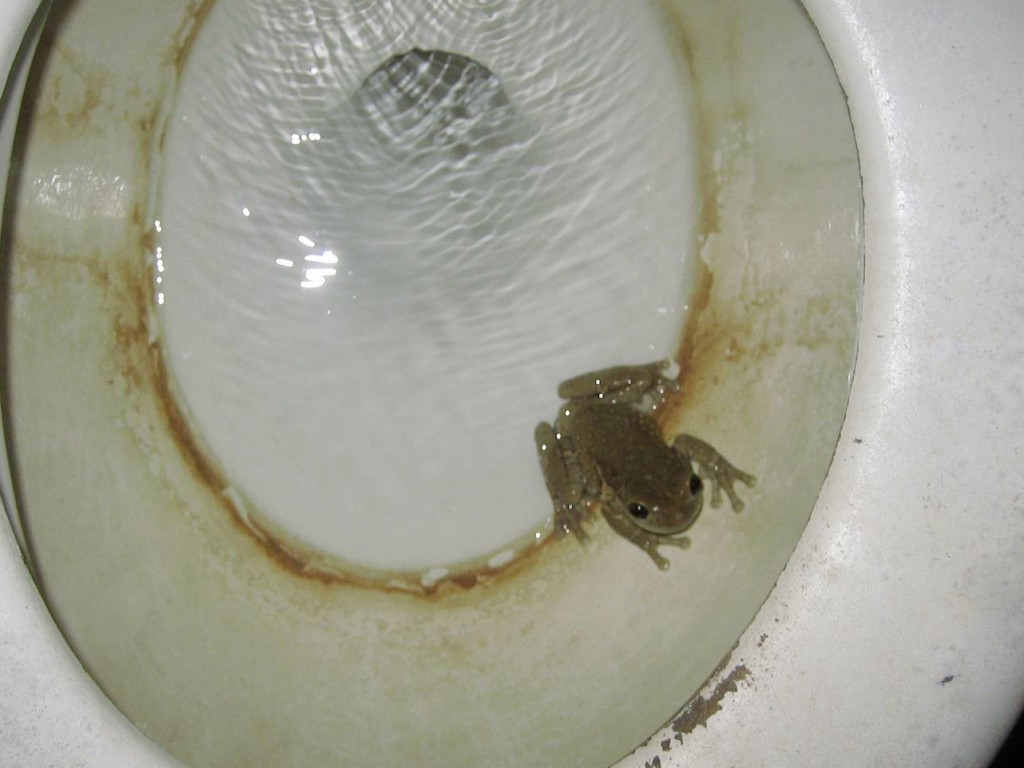 Mjólkurfroskur: Phrynohyas venulosa
By Chris Grinter, á Júlí 18, 2011 I’ll keep the ball rolling with Arctiinae and post a photo today of Ctenucha brunnea. Þetta Moth getur verið algengt í háum grös meðfram ströndum frá San Francisco til LA – þó á undanförnum áratugum tölurnar þessa Moth hafi farið lækkandi með eyðingu búsvæða og innrás ströndinni grasi (Ammophila Arenaria). But anywhere there are stands of giant ryegrass (Leymus condensatus) you should find dozens of these moths flying in the heat of the day or nectaring on toyon.
 Ctenucha brunnea (Erebidae: Arctiinae)
By Chris Grinter, á 12 júlí, 2011 Jæja eins og þú mega hafa giska myndefnið er ekki eins átakanlegum og titill minn bendir, en ég gat ekki annað en að snúast úr Guardian greininni. Mér finnst það virkilega fyndið þegar ég rekst neitt sem segir vísindamenn eru “astounded”, “undrandi”, “hneykslaður”, “undrandi”, – Ég giska á það er umræða fyrir annan tíma… Engu að síður í alvöru cool butterfly has emerged at the “Sensational Butterflies” exhibit at the British Museum in London – a bilateral gynandromorph! The Guardian reports today that this specimen of Papilio memnon just emerged and is beginning to draw small crowds of visitors. I know I’d love to see one of these alive again – although the zoo situation would take away quite a bit of the excitement. I think the only thing more exciting than seeing one of these live in the field would be to net one myself!
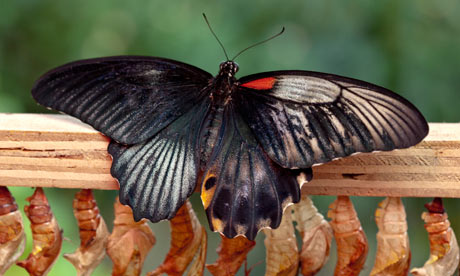
One little thing tripped my skeptical sensors and that is the quote at the end of the article taken from the curator of butterflies, Blanca Huertas. “The gynandromorph butterfly is a fascinating scientific phenomenon, and is the product of complex evolutionary processes. It is fantastic to have discovered one hatching on museum grounds, particularly as they are so rare.”
Jæja, I don’t specifically see how these are a “product of … evolutionary processes” inasmuch as allt life in allt forms is a product of evolution. These are sterile “glitches” that are cool, but not anything that has been specifically evolved for or against. Perhaps it would be more adept to call this a fascinating process of genetics (which the article actually describes with accuracy). Einnig – butterflies emerge as adults and hatch as caterpillars – but that’s just me being picky.
By Chris Grinter, þann 11. júlí, 2011 Moth í dag er falleg og sjaldgæf tegund frá SE Arizona og Mexíkó: Lerina holdgervingur (Erebidae: Arctiinae). Eins og margar aðrar dægurflugutegundir er hann ljómandi litaður og mjög líklega aposematic. Eftir allt, hýsilplantan er mjólkurgras og maðkurinn er jafn töfrandi (neðan).
 Lerina holdgervingur (Erebidae: Arctiinae)
This image of an old, spread specimen hardly does the animal justice, but one lucky photographer found a female ovipositing at the very top of a hill outside of Tucson, Arizona. While you’re at it go check out some of Philip’s other great photographs on SmugMug.
 Lerina holdgervingur - Philip Kline, BugGuide As I mentioned above this moth also has an equally impressive caterpillar that feeds on Ascleapias linaria (pineneedle milkweed).
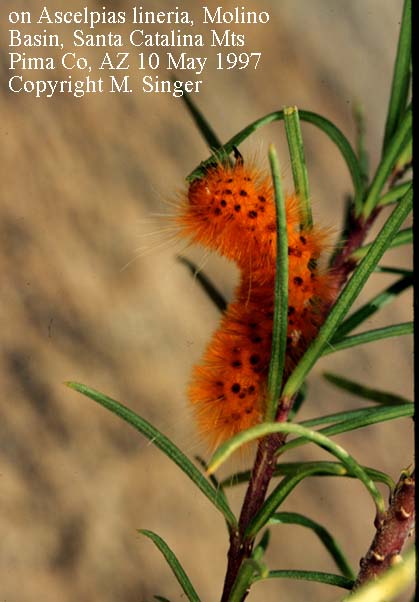
By Chris Grinter, á 5 júlí, 2011 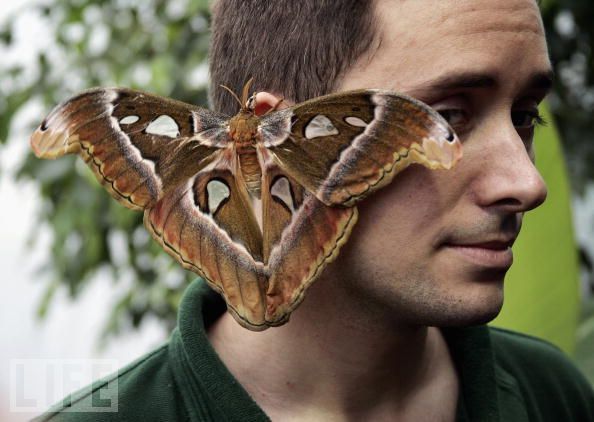
Það virðist vera yfirgnæfandi þjóðsagna í þéttbýli sem fela í sér að skordýr skríða inn í andlit okkar á meðan við sofum. Frægasta goðsögnin er eitthvað á þá leið “þú borðar 8 köngulær á ári meðan þeir sofa“. Reyndar þegar þú gúglar að talan er á bilinu frá 4 til 8… allt að pundi? Það kemur ekki á óvart að hlutirnir séu svo ýktir á netinu, sérstaklega þegar það varðar hina sívinsælu arachnophobia. Ég efast um að venjulegur Bandaríkjamaður borði meira en nokkrar köngulær alla ævi; Heimilið þitt ætti einfaldlega ekki að vera að skríða af svo mörgum köngulær að þær endi í munninum á hverju kvöldi! Svipuð goðsögn er enn goðsögn en með sannleikskorni – að eyrnalokkar grafa sig inn í heilann á næturnar til að verpa eggjum. Það er ekki satt að eyrnalokkar séu sníkjudýr úr mönnum (sem betur fer), en þeir hafa tilhneigingu til að skríða í þétt, rökum stöðum. Það er hugsanlegt að þetta hafi verið nógu oft í Ye Olde England að eyrnalokkurinn hlaut þetta alræmda nafn. Kakkalakkar hafa einnig verið skráðir sem eyrnalokkar – en hvaða skriðdýr sem gæti gengið á okkur á nóttunni gæti hugsanlega endað í einu af opunum okkar.
Ég hef hins vegar aldrei heyrt um möl sem skriðið inn í eyrað fyrr en ég rakst á þessa sögu í dag! Ég býst við að ruglaður Noctuid hafi einhvern veginn endað í eyra þessa drengs, þó ég geti ekki annað en velt því fyrir mér hvort hann hafi sett það þarna sjálfur… Mölur eru venjulega ekki að lenda á fólki á meðan það er sofandi né heldur er þeim hætt við að finna raka, þröngir staðir. En aftur á móti er allt mögulegt, sumar næturnar skríða undir gelta eða laufblöð á daginn til öruggrar felu. Ég rakst meira að segja á önnur saga af eyrnasveiflu frá Bretlandi (ekki það að Daily Mail sé virtur heimildarmaður).
Náttúrulega, sumir latur fréttaheimildir eru með því að nota skráarmyndir af “mölflugum” í stað þess að afrita myndina úr upprunalegu sögunni. Það er sérstaklega fyndið vegna þess að ein af myndunum sem notaðar eru er af nýrri tegund af mölflugu sem lýst er í fyrra eftir Bruce Walsh í Arizona. Lithophane leeae hefur komið fram á blogginu mínu tvisvar áður, en aldrei svona!
Að lokum er hér ljóð eftir Robert Cording (einnig þar sem ofangreind mynd var fundinn).
Hugleiddu þetta: mölur flýgur í eyra manns
Eitt venjulegt kvöld án þess að taka eftir ánægju.
Þegar mölur slær vængina, allir vindar
Af jörð safnast í eyra hans, öskra eins og ekkert sé
Hann hefur nokkurn tíma heyrt. Hann hristist og hristist
Höfuð hans, lætur konu sína grafa djúpt í eyrað á honum
Með Q-tip, en öskrandi mun ekki hætta.
Það virðist sem allar hurðir og gluggar
Af húsi hans hafa blásið burt í einu -
Undarlegur leikur aðstæðna yfir sem
Hann hafði aldrei stjórn, en sem hann gat hunsað
Þar til kvöldið hvarf eins og hann hefði gert
Hef aldrei lifað það. Líkami hans ekki lengur
Virðist hans eigin; hann öskrar af sársauka að drukkna
Út af vindinum inn í eyrað á honum, og bölvar Guði,
WHO, klukkustundum síðan, var góðkynja alhæfing
Í heimi sem gengur nógu vel.
Á leiðinni á spítalann, konan hans hættir
Bíllinn, segir manninum sínum að fara út,
Að sitja í grasinu. Það eru engin bílljós,
Engin götuljós, ekkert tungl. Hún tekur
Vasaljós úr hanskahólfinu
Og heldur því við eyrað á sér og, ótrúlegt,
Mýflugan flýgur í átt að ljósinu. Augun hans
Eru blautir. Honum líður eins og hann sé skyndilega pílagrímur
Á strönd óvænts heims.
Þegar hann liggur aftur í grasinu, hann er strákur
Aftur. Konan hans lýsir með vasaljósinu
Inn í himininn og þar er aðeins þögnin
Hann hefur aldrei heyrt, og litla veginn
Af ljós að fara einhvers staðar sem hann hefur aldrei verið.
— Robert Cording, Sameiginlegt líf: Ljóð (Fort Lee: CavanKerry Press, 2006), 29-30.
By Chris Grinter, þann 30. júní, 2011 
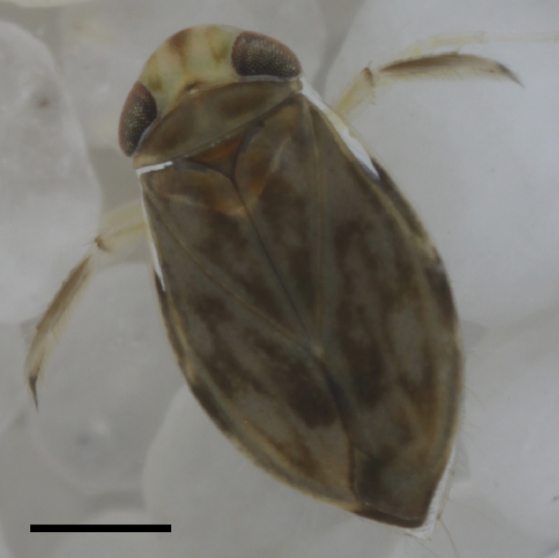 Micronecta scholtzi Hæðir evrópskrar sveita eru lifandi í kór ástvina, öskrandi, karlkyns vatnspöddur. Litla skordýrið fyrir ofan, Micronecta scholtzi (Corixidae), measures in at a whopping 2.3mm and yet produces a clicking/buzzing sound easily audible to the human ear above the water surface. To put that in perspective: trying to hear someone talk underwater while standing poolside is nearly impossible, yet this minute insect generates a click loud enough to be mistaken for a terrestrial arthropod. While that doesn’t sound too impressive when we are surrounded by other loud insects like the cicada, M. scholtzi reynist vera ótrúlega hávær dýr þegar tekið er tillit til líkamsstærðar og miðlungs sem hljóðið berst í gegnum til að ná til eyra okkar. Settu í tölur styrkleiki smellanna neðansjávar getur náð allt að 100 dB (Hljóðþrýstingsstig, SPL). Skreppa okkur inn í skordýraheiminn og þessi hljóðframleiðsla er jöfn a jackhammer í sömu fjarlægð! Svo hvað í ósköpunum hefur leyft þessari litlu pöddu að gera þennan hávaða og komast upp með það í heimi fullum af rándýrum?
Höfundar benda eðlilega á hversu óvænt þessar niðurstöður koma. Það fyrsta sem kemur í ljós er að sjómenn mega ekki hafa nein heyrnarrándýr þar sem þeir eru í rauninni að synda um og gera sem mestan hávaða líkamlega fyrir hvaða smádýr sem er.. Really this isn’t too surprising since most underwater predators are strictly visual hunters (dragonfly larvae, water bugs and beetles etc…). It is very likely that sexual selection has guided the development of these stridulatory calls into such astounding levels. The second most surprising thing is clear once you graph just how loud these insects are relative to their body size. At the top of the graph is the bottlenose dolphin (T. truncatus) with its famous sonar. But the greatest outlier is actually our little insect in the bottom left with the very highest ratio between sound and body size (31.5 with a mean of 6.9). No other known animal comes close. It is likely though that further examination of other aquatic insects may yield similar if not more surprising results!

To be more accurate about the “öskrandi”, the bugs (bugs in this instance is correct; the Corixidae belong to the order Hemiptera – the true bugs) are likely to be stridulating – rubbing together two parts to generate sound instead of exhaling air, drumming, etc… In the article the authors speculate that the “sound is produced by rubbing a pars stridens on the right paramere (genitalia appendage) against a ridge on the left lobe of the eighth abdominal segment [15]”. Without pulling up their citation, it appears that stridulation by males in the genus is well documented for mate attraction. And as you would expect, news outlets and science journalists read “genitalia appendage” and translate that to penis: and you end up with stories like this. The function of the parameres can be loosely translated to similar to mandibles in that they are opposing structures (usually armed with hairs) for grasping. The exact use of them may differ by species or even orders, but they are very distinct form the penis (=aedeagus) since they simply help facilitate mating and don’t deliver any sperm. So in reality you have genital “claspers” með “pars stridens”. And the best illustration of a pars stridens is over on the old blog Archetype. This structure is highlighted below in yellow (and happens to exist on the abdomen of the ant). En í stuttu máli – it’s a regular grooved surface akin to a washboard. In the end the sentence quoted above should be translated to “two structures at the tip of the abdomen that rub together like two fingers snapping”.
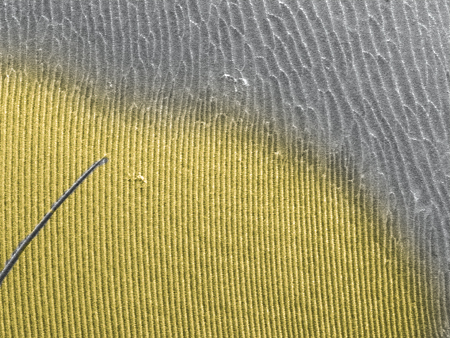 Detail of the pars stridens (in yellow) on the forth abdominal tergite in a Pachycondyla villosa worker (Scanning Electron Micrograph, Roberto Keller/AMNH) Continue reading The incredibly loud world of bug sex
By Chris Grinter, á 20 júní, 2011 Ég ætla að halda boltanum rúllandi við flokkinn og reyna að gera það reglulega meira. Ég mun einnig leggja áherslu á að leggja áherslu á nýjar tegundir í hverri viku frá hinum gríðarmiklu safni hér á California Academy of Sciences. Þetta ætti að gefa mér nóg efni fyrir… að minnsta kosti nokkur hundruð ár.
 Grammia edwardsii (Erebidae: Arctiinae) This week’s specimen is the tiger moth Grammia edwardsii. Up until a few years ago this family of moths was considered separate from the Noctuidae – but recent molecular and morphological analysis shows that it is in fact a Noctuid. The family Erebidae was pulled out from within the Noctuidae and the Arctiidae were placed therein, turning them into the subfamily Arctiinae. OK boring taxonomy out of the way – all in all, it’s a beautiful moth and almost nothing is known about it. This specimen was collected in San Francisco in 1904 – in fact almost all specimens known of this species were collected in the city around the turn of the century. While this moth looks very similar to the abundant and widespread Grammia ornata, close analysis of the eyes, wing shape and antennae maintain that this is actually a separate species. I believe the last specimen was collected around the 1920’s and it hasn’t been seen since. It is likely and unfortunate that this moth may have become extinct over the course of the last 100 years of development of the SF Bay region. Grammia, and Arctiinae in general, are not known for high levels of host specificity; they tend to be like little cows and feed on almost anything in their path. So it remains puzzling why this moth wouldn’t have habitat today, even in a city so heavily disturbed. Perhaps this moth specialized in the salt marsh areas surrounding the bay – which have all since been wiped out due to landfill for real-estate (1/3 of the entire bay was lost to fill). Or perhaps this moth remains with us even today but is never collected because it is an evasive day flying species. I always keep my eye out in the park in spring for a small orange blur…
|
Efahyggja
|














